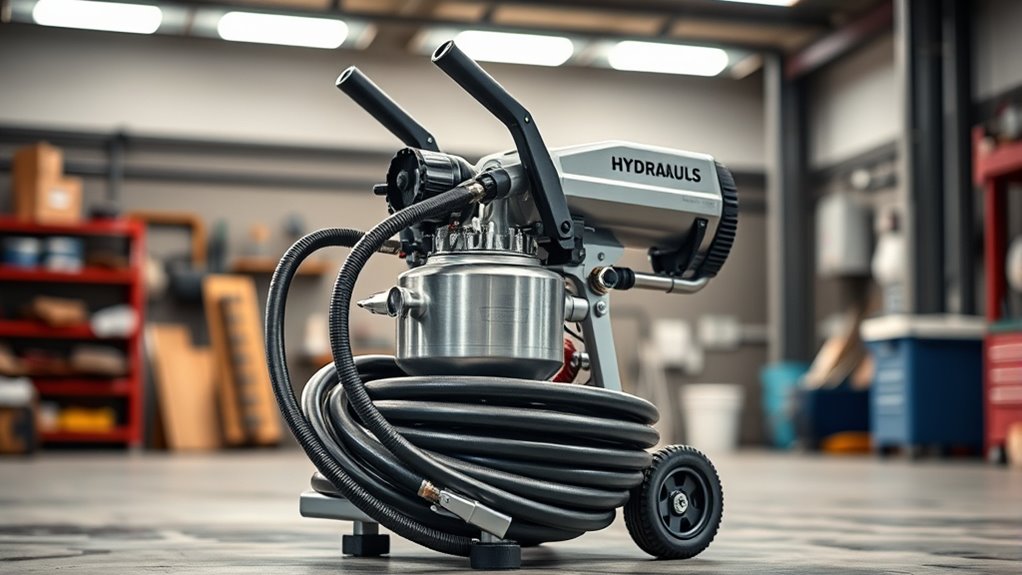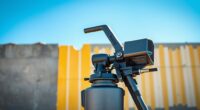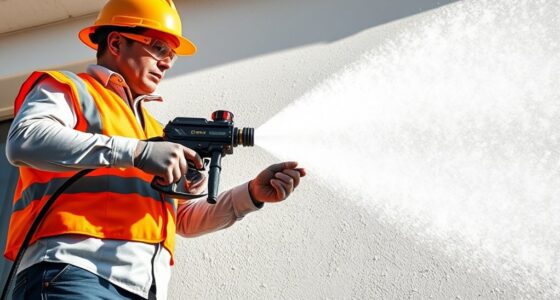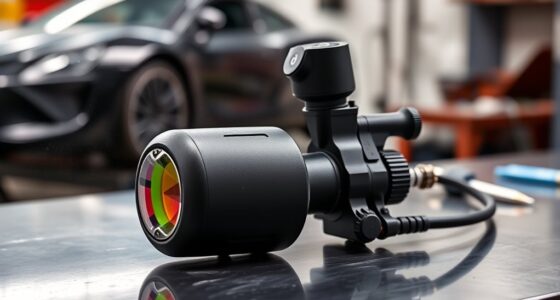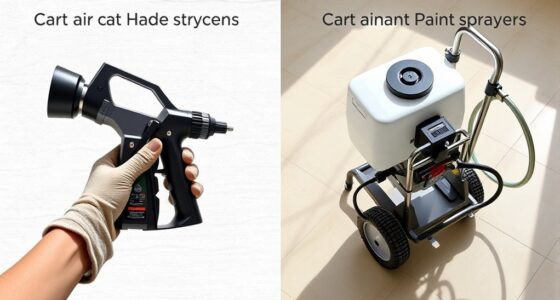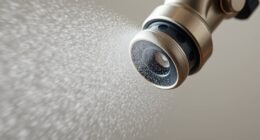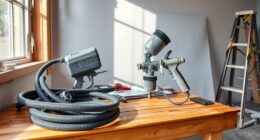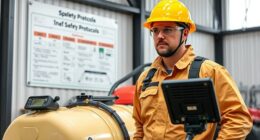Hydraulic drive airless systems are built to handle all-day production with ease. They provide steady pressure and smooth paint flow, reducing fluctuations and touch-ups. These systems are reliable and require less maintenance, so you spend less time on repairs. Plus, they operate quietly and consume less energy, making them perfect for extended jobs. If you want to discover how these advantages can boost your projects, there’s more to explore ahead.
Key Takeaways
- Hydraulic drive systems provide consistent, smooth paint flow for all-day, high-quality production.
- They offer enhanced durability and reliability, reducing downtime during extended projects.
- Quiet operation and precise pressure control improve worker comfort and application accuracy.
- These systems handle complex surfaces and large areas efficiently, minimizing touch-ups.
- Energy-efficient design supports sustainable, continuous operation for demanding painting tasks.
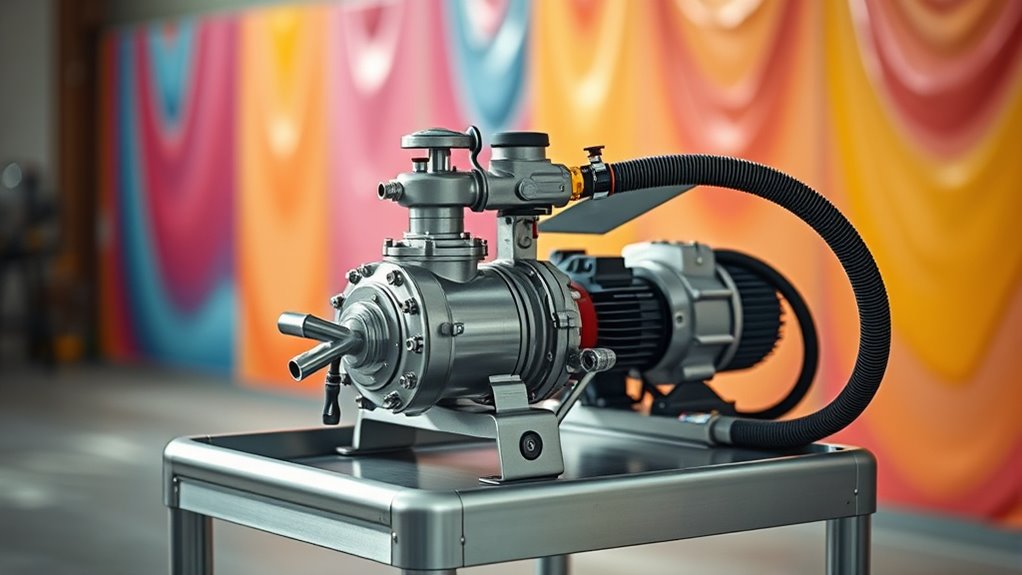
Ever wondered how hydraulic drive airless systems boost painting efficiency and precision? If you’re involved in large-scale or continuous painting projects, understanding this technology can transform the way you work. Hydraulic drive airless systems use hydraulic power rather than traditional electric motors to operate the pump, offering a range of advantages that directly impact your productivity and results. Instead of relying on electric components, these systems harness pressurized fluid to generate consistent, smooth, and controllable paint flow. This means you can achieve uniform coverage, even on complex surfaces or large areas, with less effort and fewer interruptions.
Hydraulic drive airless systems enhance painting efficiency with consistent, controllable flow for superior coverage and reduced effort.
One key benefit is the system’s ability to deliver steady pressure and flow rates throughout the entire job. Traditional electric-powered airless sprayers often experience fluctuations that can lead to uneven spray patterns or drips, especially during extended use. Hydraulic systems maintain a constant pressure, ensuring your spray pattern remains uniform from start to finish. This consistency not only improves the quality of your work but also reduces the need for touch-ups or re-coating, saving you time and material costs. Plus, the smooth operation minimizes splatter and overspray, which can be a nightmare to clean up and can compromise the quality of the finish.
Another advantage is the durability and reliability of hydraulic drive systems. Since they are built with fewer moving electrical parts that can wear out or fail, they tend to require less maintenance over time. This reliability means fewer delays, especially on long projects where downtime can be costly. Additionally, hydraulic systems often feature better heat dissipation and are less affected by environmental factors such as dust or moisture, making them suitable for job sites with challenging conditions. You’ll find that these systems can handle continuous operation without overheating or losing performance, allowing you to work longer without interruption.
Furthermore, hydraulic drive airless systems often provide a quieter operation compared to their electric counterparts. This can considerably improve your comfort during extended work hours and reduce fatigue. They also offer more precise control over pressure adjustments, giving you the ability to fine-tune spray parameters on the fly. This flexibility is invaluable when working with different materials or tackling intricate surfaces, ensuring you get the best finish possible every time. Incorporating advanced technology such as hydraulic systems also helps in reducing environmental impact by lowering energy consumption, aligning with sustainable practices. With their combination of durability, consistent performance, and operational efficiency, hydraulic drive airless systems are truly built for all-day production, helping you complete projects faster and with higher quality results.
Frequently Asked Questions
How Does Hydraulic Drive Improve Efficiency Compared to Electric Systems?
Hydraulic drive improves efficiency by providing consistent, smooth power that adapts to your workload, reducing energy waste. Unlike electric systems, it offers better control over pressure and flow, so you use only what’s necessary, saving you time and effort. You’ll experience fewer interruptions and less maintenance, meaning you can work longer without downtime. This makes hydraulic drive ideal for all-day production, helping you complete projects faster and more reliably.
What Maintenance Is Required for Hydraulic Drive Airless Systems?
You need to regularly check hydraulic fluid levels and top them off as needed to guarantee smooth operation. Keep an eye on hoses and connections for leaks or wear, replacing any damaged parts promptly. Change the hydraulic fluid according to the manufacturer’s schedule, typically after every few hundred hours of use, to prevent contamination. Additionally, inspect filters and clean or replace them to maintain system efficiency.
Can Hydraulic Drive Airless Equipment Handle Different Paint Viscosities?
Yes, hydraulic drive airless equipment can handle different paint viscosities. You just need to adjust the pressure and flow settings accordingly, which the system allows easily. This flexibility helps you paint various surfaces and materials efficiently. Keep an eye on the viscosity to prevent clogging or underperformance. Regularly check and calibrate your equipment to guarantee ideal operation, especially when switching between paints of different thicknesses.
How Does Hydraulic Drive Impact Noise Levels During Operation?
Imagine a whispering breeze replacing a roaring storm—that’s how hydraulic drive impacts noise levels during operation. You’ll notice it runs much quieter than traditional systems, creating a calmer, more comfortable workspace. This reduced noise not only minimizes fatigue but also allows you to focus better and communicate easily. With hydraulic drive, your productivity soars without the disruptive clatter, making long days more manageable and less stressful.
What Are the Safety Considerations for Hydraulic Drive Airless Sprayers?
You should always wear proper protective gear, including gloves and eye protection, when operating hydraulic drive airless sprayers. Regularly inspect hoses and fittings for leaks or damage, and make certain all safety valves are functioning correctly. Keep hands and clothing away from moving parts, and never bypass safety features. Follow the manufacturer’s instructions carefully, and shut off the equipment before performing maintenance to prevent accidents.
Conclusion
With the hydraulic drive airless, you’ll never worry about downtime again—it’s built for all-day production, pushing your work to new heights. Imagine your projects flowing seamlessly, like a river of precision and power, without a hitch. This isn’t just a tool; it’s your ultimate partner on every job site, transforming ordinary days into extraordinary ones. Trust me, once you experience its unstoppable performance, you’ll wonder how you ever painted without it.
